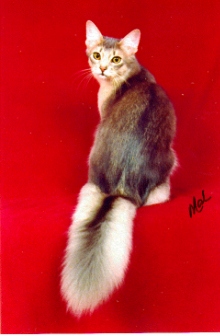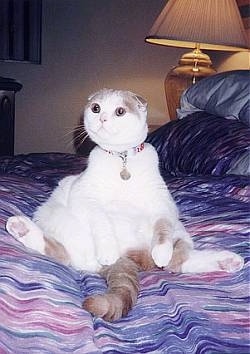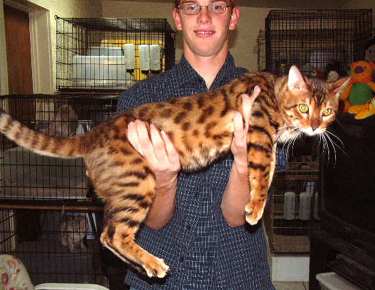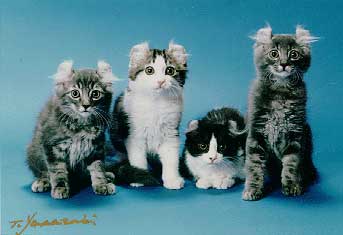|
|
Edited by Flower007 at 12-4-2015 10:41 AM
Alhamdulillah |
|
|
|
|
|
|
|
|
|
Mr.Forensics This user has been deleted
|
|
|
|
|
|
|
|
|
|
Mr.Forensics This user has been deleted
|
Senarai Breed Kucing (Incomplete)
Longhair\SemiLonghair:
American Bobtail

Asian Semi-Longhair\Tiffanie\Longhaired Burmilla

Balinese

Birman,sacred cat from burma.

British LongHair\Lowlanders

Chantilly/Tiffany

Himalayan\Colorpoint Persian

Javanese

Maine Coon,big big catss.

Nebelung,the blue-ish cats

Norwegian Forest Cat,big cat also!!

Oriental Longhair\British Angora

Persian,look at the flat face.

RagDoll,always relax

Ragamuffin,the variation of RagDoll

Siberian

Turkish Van,like to play water even sleep in the wash-basin!

Turkish Angora

Shorthair:
Abyssinian

American Shorthair

Bombay,its black,what do u expect?

British Shorthair

Burmese

Burmilla

California Spangled Cat,rarely breed

Chartreux,famous for his/her eyes!

Colorpoint Shorthair

Egyptian Mau,fastest cat at 36mph

Exotic,the shorthair version of Persian

Havana Brown,like its name says!

Korat,originally fr Thailand,also called Si-Sawat

Ocicat,spotted=Siamese+Abyssinian+American Shorthairs

Oriental Shorthair,look at the triangular wedge of my face!

Russian Blue,the another must-blue cat..

Siamese,Wichien-maat,from Thailand

Singapura,large,large eyes.

Snowshoe,rare breed,but I got shoe.whatever.

Sokoke,tabby colour,back legs longer than front ones.

Somali,long-haired abyssinian,"fox-cats"

Tonkinese,acrobatics expert.

Mutated Breed:
American Curl,love my curly-wurly earsss

American Wirehair,hair goes crazy!(my moustache too!)

Cornish Rex,the another bad-hair-day catS...

Devon Rex,also known as Pixie or Alien.freak!

Japanese Bobtail,thats ok,i like ur tail.

LaPerm,dont confuse with another rex,my coat are softer.

Manx,either short tail,or:no tail at all

Munchkin,short leg=gemuk pendek.cute!

Ojos Azules,blue eyes blue,blue,deep blue,blueee~

Peterbald,long muzzle,long legs=model

Selkirk Rex,another rex.

Scottish Fold,got controversial ears,means no cat show!

Sphynx,the very uncatlike appearance.now i give you some fur...

Breeds derived from crosses with wild felids
Bengal,playful--destructive when bored

Chausie,domestic cats marry jungle cats!

Savannah,serval+domestics,may hiss,chirp rather than meow.?

Toyger,it's a cat!it's a tiger!it's a toyger!ahahah

|
|
|
|
|
|
|
|
|
|
|
|
|
huhu.. cun sungguh.. byk lg beb jenis2 kucing nie... ko rajin2 selak laman2 web atau search jer... |
|
|
|
|
|
|
|
|
|
|
|
Jenis-Jenis Kucing
Hi semua kawan .. kiki nak berkongsi dengan semua forummer jenis2 kucing .... mempunyai
karektor tersendiri ...walaupun begitu kiki minta jangan double standard kan binatang ini .....
memberi kasih sayang hanya pada kucing yang import sahaja tapi kucing kat tepi jalan ditolak,
dikeji sebab mereka kotor dan berkurap ... aper pun jenis kucing ... mereka ini tetap memerlukan kasih sayang kita .... kiki cuma ingin berkongsi dengan kawan2 ......

The Maine Coon
One of the oldest natural breeds in North America, the Maine Coon is generally regarded as a native of the state of Maine (in fact, the Maine Coon is the official Maine State Cat).A number of attractive legends surround its origin. A wide-spread(though biologically impossible) belief is that it originated frommatings between semi-wild, domestic cats and raccoons. This myth,bolstered by the bushy tail and the most common coloring (araccoon-like brown tabby) led to the adoption of the name 'Maine Coon.'(Originally, only brown tabbies were called 'Maine Coon Cats;' cats ofother colors were referred to as 'Maine Shags.') Another popular theoryis that the Maine sprang from the six pet cats which Marie Antoinettesent to Wiscasset, Maine when she was planning to escape from Franceduring the French Revolution. Most breeders today believe that thebreed originated in matings between pre-existing shorthaired domesticcats and overseas longhairs (perhaps Angora types introduced by NewEngland seamen, or longhairs brought to America by the Vikings).First recorded in cat literature in 1861 with a mention of a blackand white cat named 'Captain Jenks of the Horse Marines,' Maine Coonswere popular competitors at early cat shows in Boston and New York. Abrown tabby female named 'Cosie' won Best Cat at the 1895 Madison SquareGarden Show.
Unfortunately, their popularity as show cats declined with the arrival in 1900 of the more flamboyant Persians. Although the MaineCoon remained a favorite cat in New England, the breed did not begin toregain its former widespread popularity until the 1950's when more andmore cat fanciers began to take notice of them, show them, and recordtheir pedigrees. In 1968, six breeders formed the Maine Coon Breedersand Fanciers Association (MCBFA) to preserve andprotect the breed. Today, MCBFA membership numbers over 1000 fanciersand 200 breeders. By 1980, all registries had recognized the MaineCoon, and it was well on its way to regaining its former glory.
Maine Coons were well established more than a century ago as ahardy, handsome breed of domestic cat, well equipped to survive thehostile New England winters. Nature is not soft-hearted. It selectsthe biggest, the brightest, the best fighters, and the best hunters tobreed successive generations. Planned breedings of Maine Coons arerelatively recent. Since planned breeding began, Maine Coon breedershave sought to preserve the Maine Coon's "natural," rugged qualities.The ideal Maine Coon is a strong, healthy cat.
Interestingly, the breed closest to the Maine Coon is the NorwegianForest Cat which, although geographically distant, evolved in much thesame climate, and lends credence to the theory that some of the catsresponsible for developing the Maine Coon were brought over by the Vikings.
Characteristics
Everything about the Maine Coon points to its adaptation to a harsh climate. Its glossy coat, heavy and water-resistant, is like that of no other breed, and must be felt to be appreciated. It is longer on the ruff, stomach and britches to protect against wet and snow, and shorter on the back and neck to guard against tangling in the underbrush. The coat falls smoothly, and is almost maintenance-free: a weekly combing is all that is usually required to keep it in top condition. The long, bushy tail which the cat wraps around himself when he curls up to sleep can protect him from cold winters. His ears are more heavily furred (both inside and on the tips) than many breeds for protection from the cold, and have a large range of movement. Big, round, tufted feet serve as 'snow shoes.' Their large eyes and ears are also survival traits, serving as they do increase sight and hearing. The relatively long, square muzzle facilitates grasping prey and lapping water from streams and puddles.
Although the Yankee myth of 30-pound cats is just that, a myth (unless the cat is grossly overweight!), these are indeed tall, muscular, big-boned cats; males commonly reach 13 to 18 pounds, with females normally weighing about 9 to 12 pounds. Add to that two or three inches of winter coat, and people will swear that they're looking at one big cat.
Maine Coons develop slowly, and don't achieve their full size until they are three to five years old. Their dispositions remain kittenish throughout their lives; they are big, gentle, good-natured goofs. Even their voices set them apart from other cats; they have a distinctive, chirping trill which they use for everything from courting to cajoling their people into playing with them. (Maine Coons love to play, and many will joyfully retrieve small items.) They rarely meow, and when they do, that soft, tiny voice doesn't fit their size!
Description
The important features of the Maine Coon are the head and body shape, and the texture and 'shag' of the coat. The head is slightly longer than it is wide, presenting a gently concave profile with high cheekbones and ears that are large, wide at the base, moderately pointed, and well tufted inside. They are set well up on the head, approximately an ear's width apart. Lynx-like tufting on the top of the ears is desirable. The neck should be medium-long, the torso long, and the chest broad. The tail should be at least as long as the torso. One of their most distinctive features is their eyes, which are large, round, expressive, and set a a slightly oblique angle. Overall, the Maine Coon should present the appearance of a well-balanced, rectangular cat.
Throughout their history there has been no restriction on the patterns and colors acceptable, with the exception of the pointed Siamese pattern. As a result, a wide range of colors and patterns are bred. Eye colors for all coat colors range through green, gold, and green-gold. Blue eyes and odd eyes, (one blue and one gold eye) are permissible in white cats. There is no requirement in the Maine Coon Standard of Perfection for particular combinations of coat color and eye color.
Maine Coon owners enjoy the breed's characteristic clown-like personality, affectionate nature, amusing habits and tricks, willingness to 'help' with any activity, and easily groomed coat. They make excellent companions for large, active families that also enjoy having dogs and other animals around. Their hardiness and ease of kittening make them a satisfying first breed for the novice breeder. For owners wishing to show, the Maine Coon has reclaimed its original glory in the show ring.
Care and Training
Most breeders recommend a high-quality dry food. Most cats can free feed without becoming overweight. Middle-aged cats (5-10) are most likely to have weight problems which can usually be controlled by switching to a low-calorie food. Many Maine Coons love water. Keep a good supply of clean, fresh water available at all times.
Most Maine Coons can be trained to accept a leash. Maine Coons are creatures of habit and they train easily if they associate the activity with something they want (they train humans easily too!).
Special Medical Problems
Individuals within any breed are fairly closely related, and have many characteristics in common. This includes genetic strengths and weaknesses. Certain genetic health disorders may be more or less of a problem in a particular breed than in other breeds. For example, a breed may have a slightly higher incidence of gum disease than the cat population as a whole, but have a lower incidence of heart disease or liver disease.
Genetic problems generally only affect a tiny minority of the breed as a whole, but since they can be eradicated by careful screening, most reputable breeders try to track such problems, both in their breeding stock and the kittens they produce. By working with a responsible breeder who will speak openly about health issues, you are encouraging sound breeding practices.
In the Maine Coon, the most common inherited health problems are hip dysplasia, which can produce lameness in a severely affected cat, and cardiomyopathy, which can produce anything from a minor heart murmur to severe heart trouble. Any breeder you talk to should be willing to discuss whether they've had any problems with these diseases in their breeding stock, or in kittens they've produced; how much screening they're doing, and why.
[ Last edited by kiki-lala at 17-8-2007 03:55 PM ] |
Rate
-
1
View Rating Log
-
|
|
|
|
|
|
|
|
|
|
|
kiki kl kucing yg biase tuh.. yg slalu bersepah tepi jalan tuh.. tuh jenis aper aar...
aku bela kucing biase2 jer... depa ni rajin main dan tak banyak songeh,,, senang mudah dan meriah |
|
|
|
|
|
|
|
|
|
|
|
nuhha pye tuchen maine coon gaks...name dia lala & lolo...tomei jek!  |
|
|
|
|
|
|
|
|
|
|
|
The American Curl

History
On a sunny day in June 1981 in Lakewood, California, a longhair silky black female kitten with unusual ears wandered up to the doorstep of Joe and Grace Ruga. Joe scrutinized the situation and determined that the most effective solution to this stray kitten problem was to ask Grace not to feed the kitten. Grace, not abiding by her husband's wishes but listening to her heart instead, left a bowl of food on the porch. The affectionate black kitten quickly worked her way into the Ruga's hearts (especially Joe's) and they named her Shulamith, which means "black but comely". Such are the beginnings of the American Curl as it is known today. True American Curls must trace their pedigree back to Shulamith, the foundation female.
In December 1981, Shulamith delivered her first litter of kittens. Out of four kittens, two had the same curly ears as Shulamith. A geneticist was contacted to study this phenomenon and he confirmed that this unusual ear was a genetic trait and was inherited in every case, causing it to be labeled a dominant gene, with no deformities attached to it. Referred to as a spontaneous mutation, the gene that causes the ear to curl appeared to be following a single dominant pattern.
Acceptance
Selective breeding and presentation of the Curls began in 1983 allowing cat fanciers their first opportunity to get a glimpse of a rare, new addition to the world of cats. Curls were first accepted for CFA registration in 1986 and achieved Provisional status in 1991 followed by their advancement to the Championship Class in February 1993, setting a precedent in CFA by being the first breed to be admitted to the Championship Class as one breed with two coat lengths. Due to their domestic ancestry, American Curls are available in both longhair and shorthair varieties and come in any color or coat pattern. Both coat lengths are presented in the Longhair Division at CFA cat shows.
Breeding partners for American Curls are limited to other Curls or non-pedigreed domestic cats which closely match the Curl breed standard with the exception of the curled ear. By outcrossing to domestic cats, the American Curl gene pool grows large and optimum health is maintained due to genetic diversity. When breeding Curl to Curl, the resulting kittens will usually all have curled ears. However, a Curl bred to a straight ear cat, regardless of whether or not it is a domestic cat or an American Curl Straight Ear, will produce at least 50% Curls and sometimes more due to the dominant nature of the curl gene. American Curl Straight Ears from such litters are very valuable in a planned breeding program and also make outstanding pets.
Characteristics and Temperment
When Curls are born, their ears are straight, but within two to ten days after birth, their ears begin to curl back. During the first 4 months, the kitten's ears will gradually curl and uncurl in varying degrees until they are set permanently at 4 months of age. At this age, breeders can determine the kitten's quality (pet, breeder, show). Along with the kitten's overall conformation to the breed standard, degree of curl to the ear is a key factor in determining quality as follows: first degree (pet), second degree (breeder), and third degree (show) being the most desirable curl to the ear, emulating the graceful curve of a full crescent. Ear furnishings (hair tufts) fanning outward from the ear accentuate and further enhance the curled ear.
The ideal American Curl is a medium sized, alert animal with an elegant appearance and a sweet, open expression complimented by their remarkable ears. Both longhair and shorthair Curls have soft, silky coats, but the longhair Curl has the distinction of sporting a beautiful plumed tail. Because both coat lengths have minimal undercoat resulting in non-matting hair, grooming an American Curl is easy -- an occasional bath and combing is all that is needed. Care should be taken when handling the ears to avoid breaking the cartilage -- do not force the ear into unnatural positions.
The Curl's temperament is one of curiosity and companionship. Being very people-oriented, they like to assist in all household projects and delight in "bumping heads" with their owners or new human acquaintances. Curls are even tempered and intelligent, yet they retain their kitten-type behavior throughout their adult life. Not overly talkative, the Curls will tell you when they need something or desire attention. American Curls easily adapt to almost any home situation and adjust to other animals remarkably well. Simply stated, they are extremely affectionate and absolutely ear-resistible!
Pricing of American Curls usually depends on each individual kitten's degree of curl, bloodlines, type and markings. Many breeders allow pickup of new kittens between 3 and 4 months of age. Along with reaching their permanent degree of curl by 4 months, kittens have had basic inoculations and developed the physical and social stability to adjust to a new environment. Four months is also the minimum age requirement for cat show participation and transportation of kittens by air. |
Rate
-
1
View Rating Log
-
|
|
|
|
|
|
|
|
|
|
|
tp nuhha cayunk je sume tuchen di muke bumi Allah taala neh...  |
|
|
|
|
|
|
|
|
|
|
|
|
erk...tmpg tnye cket...spesis american curl neh ade ke kt m'sia? |
|
|
|
|
|
|
|
|
|
|
|
|
teringin gaks nk nengok... |
|
|
|
|
|
|
|
|
|
|
|

Persian
The Persian cat was once traded for goods and valued for its beauty and temperament, aiding the beautiful, longhaired cat抯 journey across the world. The breed is thought to have originated in Persia, known today as Iran, but there are also hieroglyphics on pyramid walls that resemble the Persian cat. Today, it is the most popular breed of cat and is easily recognized, highly sought after, and greatly treasured by those who are fortunate enough to be owned one.
The most common characteristics of the Persian cat are:
* Long, soft hair
* Strong, cobby build
* Large, expressive eyes
* Chubby cheeks
* High nose, which creates the 搒mushy |
Rate
-
1
View Rating Log
-
|
|
|
|
|
|
|
|
|
|
|
me terpk gak nak bukak thread ini..TAHNIAH kat monic kerana bukak tajuk nie.. very interesting la... rupa2nya kucing nie byk jenis tau, tapi kalau kita tgk kat jalan2 & kucing terbiar tue akak rasa itu jenis yg sudah byk campur2.. maklum saja lar sosial tak der batas... main tarokk jek
anyway, kita seharusnya menyayangi semua jenis kucing yg terdapat muka bumi Allah ini... mereka semua istemewa pada ku
[ Last edited by leotazz818 at 17-8-2007 04:32 PM ] |
|
|
|
|
|
|
|
|
|
|
|
Reply #6 nuhha_ney's post
|
|
|
|
|
|
|
|
|
|
|
pitt sker sgt tgk yg jenis exotic punya...
mata bulat je... |
|
|
|
|
|
|
|
|
|
|
|
American Bobtail

At first glance you are sure that you have just seen a bobcat, you slowly turn and your gaze falls upon this magnificent and untamed looking creature. It captivates you. Your eyes meet and you are drawn to a far away place where hearts run wild and free. The cat cleans its luxurious fur, blinks its eyes at you and begins to purr. You long to stroke its soft, thick fur and hold him in your arms, but do you dare? Tentatively you reach for the amazing animal. He stands up and stretches, allowing you to marvel at his substantial body and his natural short tail. He is a thing of the wild, of that you are sure. The cat saunters over to you and demands attention, you cautiously pick him up and are amazed at his personality. Affectionate, intelligent and gentle, your heart has been stolen by an American Bobtail.
The American Bobtail is a medium-to-large, naturally occurring, bobtailed cat; a noticeably athletic animal, well muscled, with the appearance of power. The tail should be clearly visible above the back when the cat is alert and is not to exceed the hock in length. The optimum tail is articulate and nearly straight with the slightest of curves. The American Bobtail cat possesses a strong, broad modified wedge-shaped head, with a distinctive brow above large almost almond shaped eyes giving it a natural hunting gaze. Its unique coat comes in both a medium, semi-dense shorthair and a medium-length longhair that is resilient and resistant to water. When in motion, it should exhibit a natural rolling gait giving the cat with all of its combined physical characteristics the resemblance of a bobtailed wildcat. This is a slow maturing breed taking two to three years to reach full adult type.
The American Bobtail is noted for its wild look, with an exceptional disposition and adaptability.
American Bobtails are a loving, kind and incredibly intelligent cats. They are noted for their dog like personalities and their devotion to their owners. They easily adapt to a busy or quiet environment. In this breed no two tails are exactly the same. The average length of the tail is one to four inches, however this is an average, and some tails may be shorter or longer.
American Bobtails bond with their family. They get along well with most dogs and have a welcome spot in their hearts for newcomers, whether they are twolegged or four-legged. Long haul truck drivers have purchased them as cabin companions because they are known to be good travelers if introduced to it at a young age. Psychotherapists have also used them in their treatment programs because they have been found to be very well-behaved and sensitive to people in distress.
They are excellent companions for children and do not mind being carried around like a sack of potatoes. They interact well with people of all ages and serve a great purpose in the family home as a major source of entertainment due to their clown like personalities. They also offer a warm, soft shoulder to cry on when needed. They are known for their love of games and can play fetch or hide and seek for hours on end. They will often initiate a game and can be very persistent until you play with them. They are basically quiet cats in voice, however they do trill, chirp and click when delighted. They are easily leash-trained and love to go for walks. Not technically thieves, the American Bobtail抯 love of shiny objects makes it necessary to keep jewelry boxes closed and even locked.

The American Bobtail is one of the most recent breeds to be accepted for registration by the Cat Fanciers |
Rate
-
1
View Rating Log
-
|
|
|
|
|
|
|
|
|
|
|

abyssinian cat... tak pernah dgr kan jenis nie..kat mesia tak dok kot |
Rate
-
1
View Rating Log
-
|
|
|
|
|
|
|
|
|
| |
|